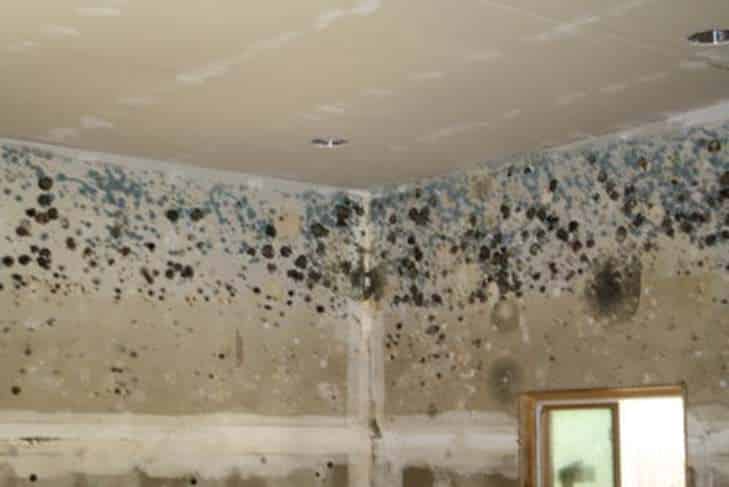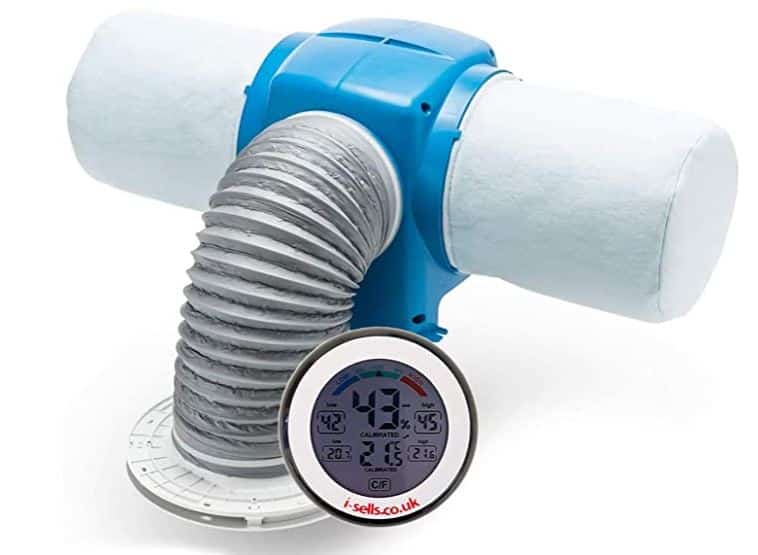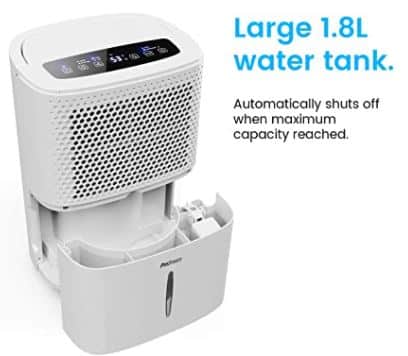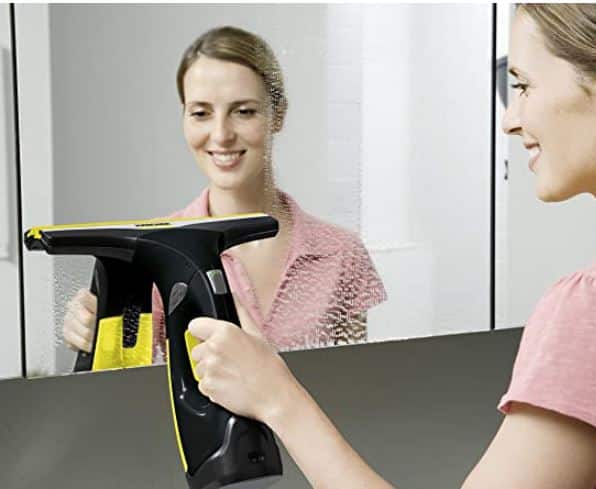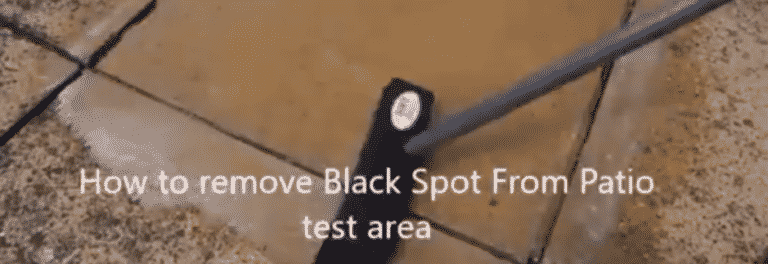How To Stop and Remove Mould
Condensation is a problem that plagues many homeowners and business owners alike. It can cause mould to grow on walls, ceilings, or floors of your home or office. Musty smells are the first sign of the problem, but there are also other symptoms such as dripping water from ceilings and pools of standing water on floors. In this article, we will discuss what condensation is and how you can stop it before it becomes a major issue for your home or office.
What is Condensation?
Condensation is the process of turning a gas into liquid. When warm, moist air comes in contact with the cold surface of your home, it will turn into water. The water then pools on the surface of your home, forming puddles that are perfect breeding grounds for mould and mildew growth. Get educated by watching the video…
I purchased this unit from Amazon, the reviews are good, I’ve had it for over a year now and we have NO condensation, highly recommend this unit see it here
What Causes Condensation?
There are many reasons why condensation can start building up in your home:
- Poor Ventilation
This is a common cause of condensation. If your home doesn’t have proper ventilation, then moist air is likely to build up and create a problem.
- Improper Insulation
If your insulation is not working properly, then it can cause high humidity levels in your home which leads to problems with condensation. If there are any cracks in walls where warm moist air can escape from outside and enter inside of the room, then that will lead to issues with condensation as well. Additionally, if you find damp spots on your ceiling when you walk into certain rooms such as bathrooms or kitchens – this could be another sign that something isn’t right with how much insulation you have around those areas of your house.
- Excessive Moisture
If you’re having a problem with excess moisture in your home, then that could also lead to condensation. This is because once the air gets too moist and warm, it can cause water droplets or mist to form on surfaces such as windows and walls which leads to problems like mould growth.
- Faulty Appliances & Equipment
When appliances break down they don’t work properly so this can contribute to an increase in humidity levels which causes issues with condensation. This is especially true for heating, ventilation and air conditioning systems which are meant to remove moisture from the air. If you notice that your home is getting colder during warm months of the year – this could be a sign that there is something wrong with your HVAC system or other appliances in your home
What Do You Need To Do To Stop Condensation?
The first step to take if you’re having issues with condensation is to find out where it’s coming from. This can, however, be difficult because sometimes humidity levels are high throughout an entire room rather than one specific area. Therefore, you can follow these tips, which will eventually help you get rid of condensation once and for all.
Make Washing Machine Is Correctly Vented
Your washing machine can cause problems with condensation if it isn’t properly vented. This is because the machine needs to release a lot of water vapor each time you use it which can lead to damp spots on your walls, floors, and ceilings as well as mould issues throughout your home. Call a professional to come and check your washing machine for you, and repair or replace the vents when necessary.
Always Close Kitchen & Bathroom Doors
Even though this sounds basic, it can really help you to control humidity levels in your home. If you keep the doors closed, then there is less chance of hot air and moisture entering these rooms – which can lead to condensation problems as well as mould issues throughout your home.
Use a Dehumidifier in Problem Areas of Your Home
If you notice that certain areas of your house such as bathrooms or kitchens are causing condensation rather than an entire room, this could be a sign that it’s time for a dehumidifier! These appliances remove excess moisture from the air so they can reduce humidity levels quickly and easily with minimal effort on your part. This will leave no place for water droplets or mist to form and cause damage all over your walls and floors.
Dry Clothes Outdoors
One of the major causes of condensation is wet clothing. If you hang your clothes to dry on the line outside can help to reduce humidity levels in your home which prevents water droplets and mist from forming all over your walls as well as damp spots on ceilings and floors – which helps you avoid mould growth altogether!
Use Pan Lids When Cooking
When you cook with water, the steam turns to moisture in your home which can lead to condensation. When this happens, it’s best that you have a pan lid in handy so that the vapors are kept inside of the pot until all of their condensed water has either left or cooled down enough for them not to be dangerous anymore.
Switch on Your Extractor Fan When Using Your Shower
When you’re taking a shower, the humidity in the bathroom can rise dramatically. To avoid this from happening, always remember to turn on your extractor fan before stepping into the bath or shower so that all of those hot and moist vapors are safely removed from your home as soon as possible!
Avoid Using Portable Gas & Paraffin Heaters
While these appliances can provide you with warmth and comfort during the cold months of winter, they also release a lot of moisture into your home which can lead to condensation. If possible, try using an electric heater instead since they don’t release any moisture during the heating process.
Tighten Up Windows & Doors to Reduce Air Flow into Your Home
Many homes aren’t very well insulated which causes hot and moist air from outdoors to be brought inside every time someone opens a window or door in their house. This leads to issues such as humidity, mould growth – and eventually condensation too! Therefore if you want to avoid having this problem yourself then make sure that windows and doors are closed tightly whenever possible.
Wipe Down All Excess Moisture Immediately After It Forms
When water droplets or mist form on walls, ceilings, floors – they need to be removed as soon as possible before they can cause any damage. To do this effectively, make sure that cleaning materials such as cloths are within reach at all times in case condensation occurs unexpectedly during regular household chores! However, it’s worth noting that this method will not offer permanent protection against condensation – but it will help to reduce the amount of damage done by water droplets and mist within your home.
Cover Up Fish Tanks & Aquariums
When you have a fish tank or an aquarium in your home, it’s important to protect it from any excess moisture and condensation. If you don’t, this could cause damage to the interior of your tank as well as lead to long-term issues such as mould growth – which can be dangerous for both humans and animals! Therefore make sure that fish tanks are covered at all times when not in use so that humidity levels within your home remain stable.
Don’t Overfill Wardrobes & Cupboards
Filling your cupboards and closets leads to poor ventilation, which can cause humidity levels to rise within your home. This leads to water droplets and mist formation – which can end up causing damage all over your home! To avoid this, avoid overfilling your cupboards and wardrobes to the brim.
Use Curtains & Blinds to Help Control Moisture Levels in Your Home
Curtains and blinds have a number of benefits for your home, one being that they help to control moisture levels by keeping it out. This stops water droplets and mist from forming on ceilings and walls within your home – which can lead to the growth of mould over time!
Ensure Your Property Has Adequate Heating
During the colder months, it’s important to ensure that your property has adequate heating. This is because the cold air outside your house causes the temperature to drop and this can cause condensation within your home. Therefore it’s important to turn on heating before you go to bed, or when you’re out of the house for a prolonged period of time – so that humidity levels always remain stable!
Move Furniture Away from External Walls
If you place furniture against your external walls, it can trap moisture within the air surrounding your home which leads to condensation. To avoid this from happening, try moving heavy pieces of furniture away from these areas so that humidity levels remain stable.
Condensation can be a serious issue for your home so it’s important to take preventative measures against this before problems arise. If you follow these tips, condensation will be a thing of the past. Good luck!
How to stop condensation
Condensation is a major cause of dampness in many UK homes, especially in winter. The good news is that it is fairly easy and inexpensive to solve. The bad news is that if you ignore this problem it can lead to a range of issues and even pose a health risk.
So what is condensation?
Condensation is formed when the water carried on warmer air comes in contact with a colder surface, causing the vapour to form into tiny water droplets. This water vapour gets into the home in a variety of ways.
- In the kitchen. Boiling the kettle and cooking creates steam which turns into condensation, creating areas where the water builds up in droplets. Often this will affect hard to see areas such as behind kitchen cupboards.
- The bathroom. This is a problem area as the hot water creates steam which then cools and creates condensation on the walls, ceilings and windows.
- Drying clothes indoors creates condensation because as the damp leaves the clothing, this is converted to water. A tumble drier with no outside vent is a leading cause of condensation as is leaving clothes to dry on a radiator.
- Breathing causes condensation. On average we expel around 1 litres of water each night. This water has to go somewhere and usually that means down the windows and walls.
- Condensation is caused by extremes of temperature. If some areas of the house are kept warm and others cold, the water vapour will form into condensation when it comes in contact with a cooler surface.
On average 24 pints (10 litres) of water are produced in the average household over the course of a day.
What does condensation do to a home?
Condensation causes damp. It can lead to peeling plasterwork or paint. Left untreated, condensation can cause the appearance of black mould spots often appearing in the corners and the ceilings of a room.
Black mould is dangerous for health and causes poor air quality. It can trigger breathing problems such as asthma caused by the myotoxins in this fungal growth.
Condensation causes a damp odour. You will find that the sour damp smell gets into your clothes and fabrics and is immediately noticeable by everyone you come in contact with.
Condensation causes dust mites to spread. It provides the perfect environment for these microscopic bugs to flourish, triggering allergies and skin irritation.
How to deal with condensation
The best way to decrease condensation is to ventilate your home. Leaving some windows open and immediately wiping down areas where the condensation has gathered will help alleviate the problem, but it won’t solve it.
Removing any mould spots with a bleach based product is equally important. However unless you deal with the condensation problem at source, this is only a temporary measure that will not prevent it coming back.
Many people try redecorating and applying fungicide to walls and ceilings but unless the source of the problem is addressed, it is not a permanent solution.
So how do you remove condensation permanently?
The most effective way to remove condensation permanently is to increase the level of ventilation in your property. Obviously keeping some of your windows open will help but it will not solve the complete problem.
The Nuaire Drimaster Eco Hall Control Diffuser Positive Input Ventilation Unit offers a unique and permanent solution to condensation. Invented in 1972 by Nuaire, the PIV unit improves ventilation by filtering the air and by transporting water laden air to the outside, while replacing it with dry clean filtered fresh air drawn into the property on a continuous basis.
The Drimaster range uses Positive Input Ventilation (PIV) technology that can easily be fitted into any loft space in around an hour. The unit will remove excess water and condensation within your home and transform it into a warm, dry and welcoming environment immediately.
Made in the UK, the Nuaire Drimaster PIV comes with a full 7 year guarantee and with over 1 million homes in the UK already benefiting from this solution to damp and condensation; you know this is a product you can trust.
There are other ways of reducing condensation in your home of course. But for a permanent solution only the Nuaire Drimaster Eco Hall Control Diffuser Positive Input Ventilation Unit offers such an easy and permanent solution.
Highest Reviewed Dehumidifiers
A dehumidifier can be an effective way of reducing condensation. It works by sucking in water laden air, removing the moisture and then blowing the now dry air back into the atmosphere.
There are two types of dehumidifiers on the market and although they both do the same, they work in slightly different ways. So let’s take a look.
Absorption dehumidifier
This is the simplest type of dehumidifier. It sucks in the water which is then absorbed in a pad within the unit. This can be effective for damp and condensation but you do need to regularly empty the water so some customers may find it inconvenient.
Refrigeration dehumidifier
This works in a similar way to an air conditioning unit. The warm air is sucked in on one side of the unit and an electric fan draws it in. As the air cools, the water drips downwards to a collecting tray. The air is then reheated to room temperature and pumped back into the room. An automatic float sensor in the collecting tray notifies you when the water needs to be emptied.
Advantages of a dehumidifier
Both types of dehumidifier can be very effective. A dehumidifier will make your living space much drier and more comfortable and because they come in a range of sizes and specifications, you can find the dehumidifier that is most suitable for your needs and your budget.
So whether you have a problem area in your home such as your kitchen or laundry room, or you want to remove humidity from the entire house, you can find the right unit for your requirements.
Many dehumidifiers are portable so you can use them where you need them most.
It is important to choose the right unit because they can vary a great deal in price and capabilities. In addition you do need to consider the power consumption. The greater the capacity for water removal, the more power you will need.
The capacity of a dehumidifier is always measured in pints of water collected over 24 hours and even the most basic models will offer an option whereby you can select the required humidity levels. You do not need to make the home bone dry to remove damp and condensation and there is always a sweet spot that gives you the optimum performance.
Disadvantages of a dehumidifier
A built in dehumidifier for the whole house is expensive to run and to install. The portable units are generally preferable but all dehumidifiers need basic maintenance such as cleaning the filters and emptying the water and they can be surprisingly noisy to run.
To make sure you buy the best unit for your needs, always check through the specifications before you commit.
Top Rated and Reviewed Window Vacuums
A window vacuum is an easy way to keep your windows clear and streak free as well as help you deal instantly with condensation. A good quality window vacuum will remove condensation from the window panes and the window sills without leaving streaks or smears. In addition you can use it round the house for the same purpose, such as in the bathroom and kitchen.
A window vacuum makes housework easy. It is ideal for using on glassy surfaces such as windows, tiles and mirrors and because it is designed to deal with liquid spills and condensation it offers a fast way to remove excess moisture.
Most window vacuums are cordless and are perfectly adapted to operating in tight corners and difficult to clean areas. You can usually expect a run time of between 20 – 45 minutes before it needs recharging and using this handy device does make cleaning a more streamlined and enjoyable experience.
Although a window vacuum will not solve your home’s condensation problem, it will definately help minimise it. A damp problem in any home is often the accumulation of numerous sources of condensation so taking action when you notice it will definitely keep damp down.
Ideal for using in the kitchen, the bathroom, laundry room or anywhere else with a condensation problem, a window vacuum prevents moisture and mould from gaining a hold in your property and it will keep your home feeling much drier.
A window vacuum will not prevent condensation but it will clear it away easily and efficiently so can be considered a cost effective preventative. Prices vary but you can buy a hand held window vacuum for anything from between £20 to £100 for a professional model.
Mould and Mildew cleaning
Condensation and damp leads to mould and mildew. This is often most noticeable in the bathroom or kitchen but can also affect walls, ceilings and hard to reach areas such as the back of cupboards and units.
The differences between mould and mildew
Mould is a fungus that grows in the form of black and green patches that can penetrate deep beneath the surface of the affected area. There are roughly a 1000 different types of mould but in general most household moulds fall into 5 categories
- Alternaria grows in damp places such as bathrooms. It is black and sometimes has a brown furry appearance. This type of mould is dangerous because it can provoke allergic reactions and breathing difficulties such as asthma.
- Aspergillus is very common. It looks black, green or yellow and usually grows on walls. It can cause breathing difficulties.
- Stachybotrys chartarum is black mould that contains myotoxins which are dangerous to health. This often grows as a result of condensation.
- Penicillum is green and has a strong musty odour. It usually affects materials that have had contact with water such as wallpaper and carpeting in a damp house.
- Mildew is a type of mould that tends to affect only the surface area so is much easier to clean. It often affects plants but it can develop indoors too and can pose a risk to health.
If you have mould and mildew in your home, you will need to ensure that you can remove this thoroughly or it could pose a serious risk to health.
How do you clean mould and mildew affected surfaces?
The good news is that all mould and mildew can be cleaned with the same product; you don’t need to identify the strain you may have growing in your home in order to remove it.
There are household remedies such as white vinegar, baking powder and household bleach that can be very effective but in most cases a product designed for the purpose will be easier to use.
Many mould and mildew removers contain disinfectant as well as a bleach solution and can kill off mould regrowth and bacteria in as little as 10 minutes. You do need to be careful when using as these types of products can be dangerous but they are extremely easy to use as well as powerful.
Cleaning mould and mildew does not solve a damp issue
Although it is essential to clean away mould and mildew from your home, it is important to remember that unless you make changes to the environment, it will all grow back very quickly.
One of the leading causes of mould is condensation caused by poor ventilation, so after you have removed the mould you will need to consider how to remove it permanently by improving the air flow to your home. Unless you do this, you will never be able to clear your home from mould, no matter how often you clean it or the product you choose.
However if you do have a damp problem in your home, your first step should be to clean away mould and mildew. Once you have done this then you can adopt a more efficient way to reduce condensation.
